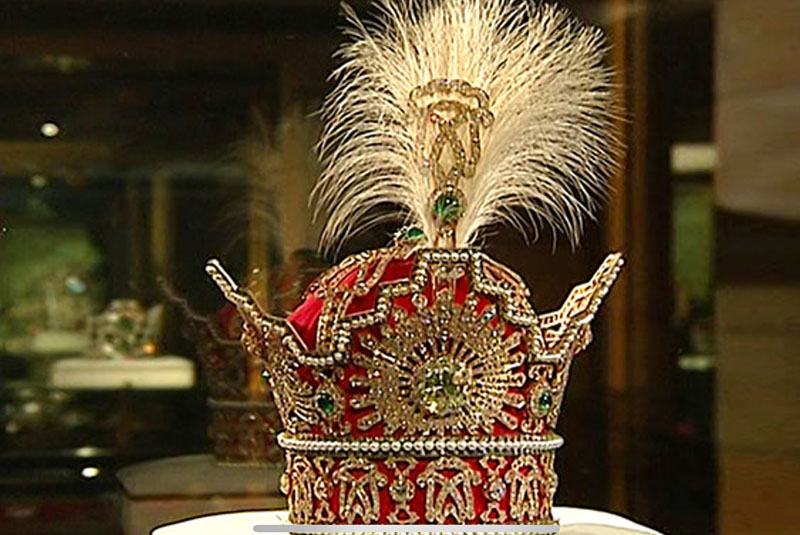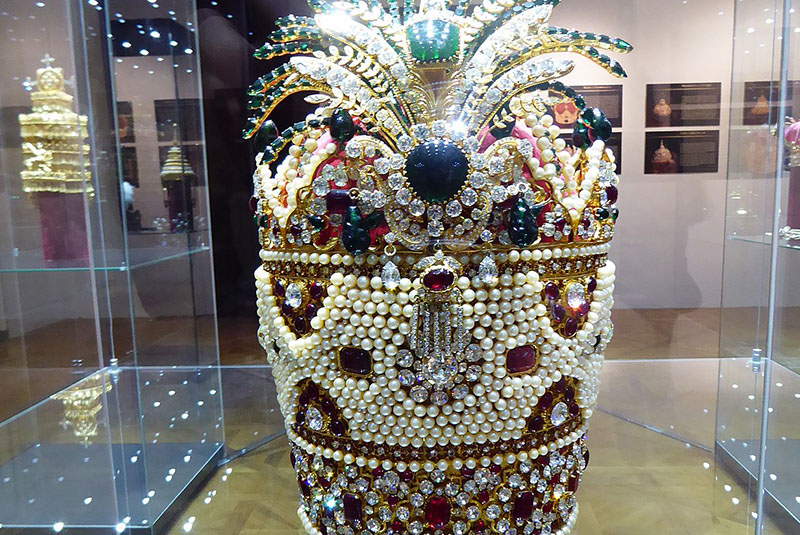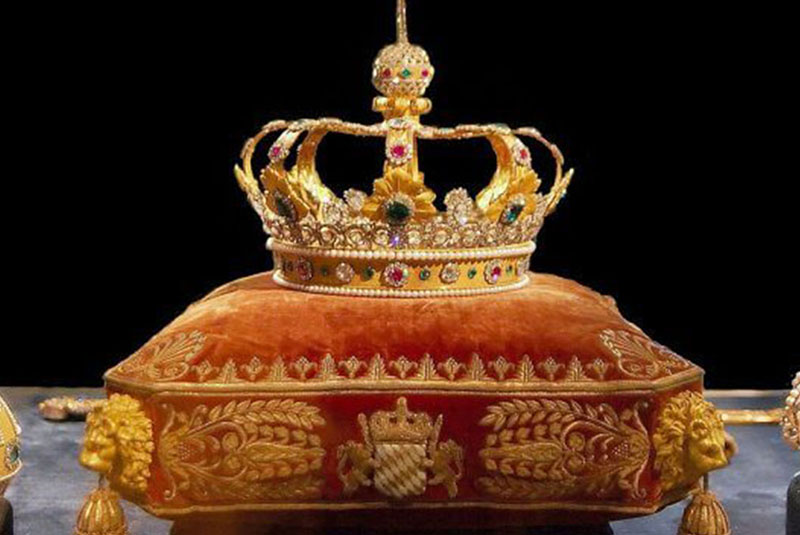National Jewelry Museum of Iran
There are a few museums in the world which exhibit the magnificent and invaluable collection of jewelry.
National Jewelry Museum of Iran is one of those, so if you are in Tehran, or planning to travel to Tehran, don’t forget to consider the museum in your list of visits. The collection could be considered as one of the most unique and expensive in the world, which has been collected over the past few centuries. It is without a doubt that, the museum is one of the best places to visit when you travel to Tehran. Here, we are going to briefly introduce this magnificent museum.
| Related tour packages: Iran Cultural Tours
National Jewelry Museum of Iran: An Overview

The collection includes elaborate crowns, thirty tiaras, numbers of aigrettes, a dozen bejeweled swords and shields, precious gems, numerous plates and other dining services cast in precious metals which encrusted with gems, and so many other items. All the items not only are valuable and beautiful, but also has a history behind, and most of them recall memories of bitter-sweet victories and defeats.
When watching the collection, every visitor should lighten up her imagination and think about the history, and the stories behind every piece. The collection can tell you about the culture and civilization in Iran, in addition to how adventurous were the kings in the past.
| Related: Best Museums in Tehran
History of National Jewelry Museum of Iran
During the 16th century, the Safavid kings have started collecting the Treasury of National Jewels for the first time. Before that, jewels of the royal family kept in the government treasury, but during the Safavid dynasty, foreign travelers who were guests at Royal Palace, started talking about the importance of a collection at one place, and therefore the Safavid kings started collecting the items at a place.
International traders who passed Isfahan through the Silk Road brought many unique items from India, the Ottoman Empire, and European countries like France and Italy to Isfahan, which was the capital city at that time. The other source of the jewels were legacy of the previous rulers, gems extracted from the mines of Khorasan and Turkestan, the Persian Gulf for pearls, and gifts to the Royal Families from other countries.

Nader Shah Afshar invaded India and occupied Delhi. Therefore, the king of India; Mohammad Shah agreed to transfer consignments of jewelry, guns, and weapons to Nader Shah in return for his pledge of truce. However, when returning to Iran, some items were damaged or lost. According to the tradition, Nader Shah had to distribute some of the items among the neighbor countries such as Ottoman Emperor; Soltan Mahmoud, the Russian Queen Elizabeth, and Bukhara ruler Abolfeiz Khan. He also presented some of the gems and jewels to the holy shrine of Imam Reza in Mashhad. Among all the items he brought from India, the most famous one was “Darya-i-Nur r” diamond, which is with 182 carats, one of the largest cut diamonds in the world. Its color is pale pink which is not a common color for diamonds.
The other magnificent items at the collection are the Takhte Tavoos bed, and the Kiani Crown. Both of these were built by the order of Fatthali Shah Qajar. He also bought and added 48 pieces of large yellow diamonds to the collection. In addition to these items, a gemmed globe added to the collection which shows his passion for collecting and preserving jewels.
In 1937, the Iranian Parliament passed a law by which a major part of the royal treasury had to transfer to the National Bank of Iran in order to strengthen the bank's financial power and the monetary system. Later, in 1960, all the Royal Jewelry, and the whole collection transferred to a division of the newly established Central Bank which is now the National Jewelry Museum of Iran.
| Suggestion: Top 23 Museums in Iran + Photos
Value of the collection of the National Jewelry Museum of Iran
We can talk and talk about the magnificent items in the 36 showcases at the museum. However, due to unique items in the collection, no one can truly determine the value of these items. What should be considered when talking about value is that it is not always about pricing a collection, but understanding the influence of the collection on history, civilization, and other items.
The Most Valuable Objects of the Collection
While the collection of National Jewelry Museum of Iran is invaluable, there are some items that stand out from the other. Here is the list of 6 objects which are the most valuable objects of the collection.

Darya-i-Nur
The famous Darya-i-Nur or Sea of light is the largest pink diamond of the world and takes the first place among the diamonds in the National Jewelry Museum of Iran. This famous diamond along with its mate, the Kooh-i-Nur, or Mountain of Light, has always come together in history. Both of these magnificent stones were in the possession of Nadir Shah. However, after his death, Ahmad Shah Durrani took Kooh-i-Nur to Afghanistan. Later East India Company obtained it and presented it as a gift to Queen Victoria. It is presently in the Queen Mother’s Crown in England.
The Darya-i-Nur diamond was inherited by Shahrokh Mirza, the grandson of Nadir Shah. It then came into the possession of Amir Alam Khan Khozeimeh, and later, Lotfali Khan Zand who was defeated by Agha Mohammad Khan Qajar. As a result, the diamond came into the treasury of the Qajar kings. Later, Darye-i-Nur entered the National Jewelry Museum of Iran. The weight of Darya-i-Nur is approximately 182 carats, and its colors are pale pink --- one of the rare colors for diamonds.
Crown of Pahlavi
This crown which was used by Reza Khan and Mohammad Reza Pahlavi is made of gold and silver, and it is decorated with diamonds, emeralds, sapphires, and pearls. The fabric of the crown is red velvet. The general design is in the style of the crown of the Sassanid kings (226-651 AD). Inside the front sun design, there is a very large yellow diamond.
A group of Iranian jewelers, under the supervision of Haj Serajeddin (the famous jeweler who had been jeweler to the Amir of Bokhara, and had emigrated from Russia to Iran), undertook to make this crown, using selected stones from the Treasury.
Nadir Aigrette
The Nadir Aigrette set with diamonds and emeralds. The central emerald is cabochon and of very good color. The tri-colored flags have pale rubies and emeralds. The whole aigrette is set with very good, rose cut diamonds. Reza Khan Pahlavi often used this aigrette, which weighs 781 carats.
Kiani Crown
Crown of Fath-Ali Shah Qajar known as “Kiani Crown” and set with diamonds, emeralds, rubies, and pearls. The final red stone is Aurangzib spinel. This crown was made during the reign of Fath-Ali Shah, and was used by succeeding kings.
Globe of Jewels
The Globe of Jewels was made in 1869 AD by order of Nasser-ed-din Shah, under the supervision of Ebrahim Massihi. The net gold used in this Globe is 34.00 kilograms and the total weight of the stones is 3,656 grams. The total number of stones used is 51,366 pieces. The diameter of the Globe is about 66 centimeters. The stand is of gold and studded with gems.
The oceans and seas are identified in emeralds and lands are shown in rubies. Southeast Asia, Iran, England and France are specified with diamonds. India is shown in pale rubies. Central and South Africa are shown in sapphires. The equator, as well as other geographical lines, is in diamonds and rubies.
Peacock Throne (Sun Throne)
During the reign of Fath-Ali Shah and by his order, a great throne was made under the supervision of Nezamoldoleh Mohammad Hossein Khan Sadr Esfahani, the governor of Isfahan. Using gold and the loose stones of the treasury. (Early 19th century). As a design of sun encrusted with precious stones was used at the top of the throne, it became famous as the “Sun Throne”. After the marriage of Fath-AliShah with Tavous Tajodoleh, due to her name, the throne was named “Peacock Throne”.
| Suggestion: National Museum of Iran - Iranian Largest Archeological Museum
Public Exhibition of National Jewelry Museum of Iran

The museum is open to the public to visit and enjoy this magnificent collection. However, due to maximum security at the place, there are some rules and restrictions. You are not allowed to take anything with you including your bag or any type of food or drink with you to the main hall of the exhibition. There are two security gates, when you passed the first one, you have to put all your belongings in a safe box. After the second security check, you go through a hallway by passing some stairs, and then you will find yourself in a huge safe box which is used as the exhibition hall.
About every 10 people as a group visit the museum with a tour guide. The visit usually takes about 45 minutes.
| Suggestion: Tehran's Most Famous Palaces
Address and Opening Hours of National Jewelry Museum of Iran
Affiliated: Iran's Central Bank
Address: Central Bank of I.R. Iran, National Jewelry Museum of Iran, Ferdowsi Ave., Tehran, Iran
Phone: (+98 21) 6446 3785, 6446 3869, 6446 3870
Visiting days and hours: Saturday to Tuesday, 14.00 - 16.30.
Closed on Wednesdays, weekends and Public Holidays
*** Children under 12 years of age are not admitted to the Treasury.


Comment
Leave a Comment